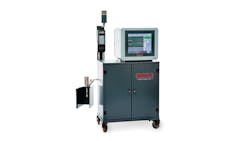With the help of a U.S. Dept. of Energy grant, Caterpillar Inc. is taking a fresh look at compacted graphite iron as a high-strength, lightweight material for diesel engine structures. The agricultural and off-road equipment builder will work with the University of Alabama at Birmingham’s Dept. of Material Science and Engineering laboratories, where a new Sintercast AB process control package will be installed this year to develop new CGI products for Caterpillar’s applications.
Funding for Caterpillar’s project stems from a $3.47-million grant by the U.S. Dept. of Energy, to “develop new, high‐strength ferrous alloys for cylinder heads and engine blocks to allow for higher cylinder pressures and increased engine efficiency.”
"By investing in next-generation vehicle materials and components, we are helping U.S. manufacturers improve the fuel efficiency of our cars and trucks and ensuring American companies remain at the cutting-edge of the global auto industry," U.S. Energy Secretary Steven Chu said, announcing the research in January 2012. "Lighter, stronger materials will help improve the performance of our vehicles while saving families and businesses money at the pump."
Overall, DOE’s $14.2-million program grants funds to Ford, General Motors, the U.S. Automotive Materials Partnership, and the Oak Ridge National Laboratory, as well as to Caterpillar.
Last year, DOE indicated Caterpillar would develop a cost model for the new components, for comparison with current production components.
Now, SinterCast details further that the objective for Caterpillar and UAB is to develop cost-effective, high-strength cast materials that support increases in specific power density (horsepower/weight) and increased thermal efficiency for heavy-duty diesel engines.
"This project reinforces the need for continuous advances in engine performance and efficiency, and the need for advanced materials to support these objectives while ensuring durability and emissions compliance,” according to SinterCast president and CEO Dr. Steve Dawson. “These demands, and the opportunities for CGI growth, are particularly applicable in heavy-duty engine applications, defined by this project as the 10- to 17-liter displacement range, for engines with more than 350 horsepower.”
High-Strength Alloys for Heads, Blocks
CGI is a specialty grade of cast iron that has greater tensile strength, stiffness, and fatigue strength than gray iron or aluminum, and it has gained wide popularity among engine manufacturers seeking to reduce weight, noise, and emissions for their designs.
SinterCast developed the most widely used process for commercial CGI production. It licenses the process to numerous automotive foundries worldwide, which use it to cast more than 50 components in series production.
Some foundries use a laboratory-scale version to test new applications. Working under a separate agreement, UAB will install SinterCast’s Mini-System 3000 equipment, and SinterCast will provide technical support to the research with Caterpillar.
Caterpillar is listed by SinterCast among numerous OEMs to have incorporated its CGI products in the past.
"Building on our successful experience with compacted graphite iron in commercial vehicle engine applications, we look forward to this unique opportunity to explore leap-frog material advances," Dr. Dawson continued.
The University has two casting laboratories, including 500-lb. and 100-lb. hydraulic tilt-box furnaces, with a 175-KW power supply. Material research systems include optical and stereomicroscopes with digital cameras for direct image acquisition and image processing software. The lab also has scanning electron microscopy (SEM), casting simulation software, and casting modeling technologies.
About the Author
Robert Brooks
Content Director
Robert Brooks has been a business-to-business reporter, writer, editor, and columnist for more than 20 years, specializing in the primary metal and basic manufacturing industries. His work has covered a wide range of topics, including process technology, resource development, material selection, product design, workforce development, and industrial market strategies, among others.
